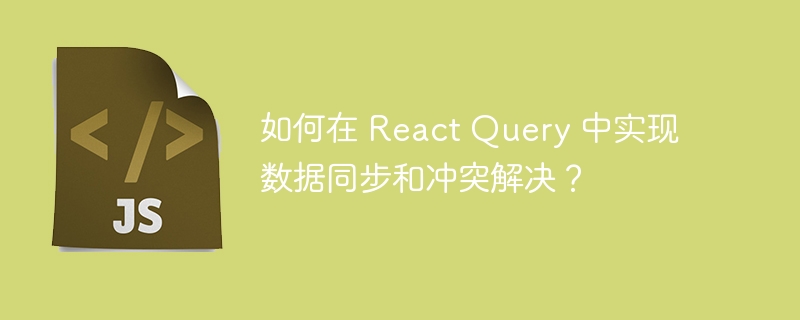Home >Web Front-end >JS Tutorial >How to implement data synchronization and conflict resolution in React Query?
How to implement data synchronization and conflict resolution in React Query?
- WBOYWBOYWBOYWBOYWBOYWBOYWBOYWBOYWBOYWBOYWBOYWBOYWBOriginal
- 2023-09-28 15:49:10785browse

How to implement data synchronization and conflict resolution in React Query?
React Query is a library for data management and interaction with the server. It provides functions such as data query, caching, and data synchronization. When using React Query for data synchronization, it is very common to encounter conflicts. This article will introduce how to implement data synchronization and conflict resolution in React Query, and provide specific code examples.
1. The concept and principle of data synchronization
Data synchronization refers to keeping the client's data consistent with the server's data. In React Query, you can automatically re-query data regularly by setting the refetchOnMount and refetchInterval properties of the query hook to achieve data synchronization.
The specific implementation is as follows:
import { useQuery } from 'react-query';
const MyComponent = () => {
const { data, isLoading, isError } = useQuery('myData', fetchMyData, {
refetchOnMount: true,
refetchInterval: 5000, // 设置为 5 秒自动重新查询一次数据
});
if (isLoading) {
return <div>Loading...</div>;
}
if (isError) {
return <div>Error occurred!</div>;
}
return (
<div>
{/* 渲染数据 */}
</div>
);
};2. The concept and principle of conflict resolution
When multiple users modify the same data at the same time, conflicts may occur. The goal of conflict resolution is to merge the server's latest data with the client's modifications and preserve the modifications of both parties as much as possible.
React Query provides a useMutation hook for sending data modification requests, and can use the onSettled callback function to handle data synchronization and conflict resolution after the request is completed.
The specific implementation is as follows:
import { useMutation, useQueryClient } from 'react-query';
const MyComponent = () => {
const queryClient = useQueryClient();
const mutation = useMutation(updateData, {
// 请求完成后执行回调函数
onSettled: (data, error, variables, context) => {
// 处理请求完成后的数据同步和冲突解决
if (error) {
console.error(`Error occurred: ${error}`);
return;
}
// 更新查询缓存中的数据
queryClient.setQueryData('myData', data);
},
});
// 处理数据修改
const handleUpdateData = () => {
const newData = // 获取要修改的数据
mutation.mutate(newData);
};
return (
<div>
<button onClick={handleUpdateData}>Update Data</button>
</div>
);
};In the above code example, updateData is the function that sends a data modification request, mutation.mutate(newData) Used to trigger requests. In the onSettled callback function, data synchronization and conflict resolution operations can be performed based on the request results, such as updating the data in the query cache through queryClient.setQueryData.
Summary
Implementing data synchronization and conflict resolution in React Query is a very important function. You can set the query hook's refetchOnMount and refetchInterval Properties implement data synchronization, using useMutation hooks and onSettled callback functions to handle the completion of data modification requests and data synchronization, thereby realizing the functions of data synchronization and conflict resolution. The above code examples provide specific implementation methods and can be adjusted and expanded according to actual conditions.
The above is the detailed content of How to implement data synchronization and conflict resolution in React Query?. For more information, please follow other related articles on the PHP Chinese website!
Related articles
See more- Javascript blur and click conflict resolution solution
- PHP real-time data synchronization technology implementation
- How to handle conflict resolution and data consistency of form data in Java?
- How to implement data synchronization and backup functions in accounting systems - Methods of developing data synchronization and backup using PHP
- Data cache merging using React Query and database

